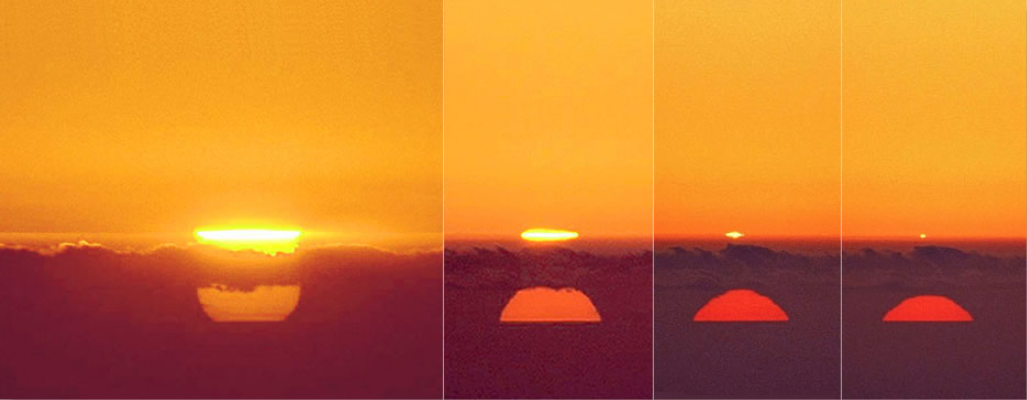Paranal, Chile Sunset
Paranal, Chile Sunset: A Spectacular Atmospheric Optics Phenomenon
The Paranal Observatory, located in the Atacama Desert of Chile, is renowned for its stunning sunsets. One particular evening in January 2002, astronomer Luc Arnold from the Observatoire de Haute-Provence in France witnessed an extraordinary event: a double sunset mirage. This captivating apparition occurred at the European Southern Observatory Very Large Telescope array, which consists of four 8.2-meter reflectors, situated at an altitude of 2,400 meters.
As the sun descended towards the Pacific Ocean, which lay 12 kilometers away, an impressive mirage unfolded before Arnold's eyes. The upper image of the sun appeared incredibly bright and highly flattened due to the presence of a strong inversion layer. This layer manifested as a hazy band surrounding the sun, creating a striking visual effect.
Beneath this upper inversion layer, a band of marine stratus clouds obscured the details below. These clouds added an additional layer of mystery to the spectacle. However, the most intriguing aspect of this phenomenon was the presence of a second, erect image of the sun setting into the ocean horizon below the clouds. This lower sun image appeared relatively undistorted compared to typical mirages.
To explain the existence of this lower sun image, scientists hypothesize the presence of a second inversion layer, positioned lower and stronger than the upper one. This lower inversion layer would generate the lower erect image and potentially parts of an inverted image that remained hidden by the clouds. The relatively clear and undistorted appearance of the lower sun image can be attributed to the fact that it is viewed considerably below the astronomical horizon. Consequently, the rays pass through the air layers at a less 'edge-on' angle, resulting in reduced distortion.
This mesmerizing atmospheric optics phenomenon observed at Paranal Observatory showcases the complexity and beauty of nature's optical illusions. The convergence of multiple atmospheric layers, including inversions and clouds, contributes to the creation of this rare double sunset mirage.
In conclusion, the Paranal, Chile sunset is a captivating event that mesmerizes both astronomers and nature enthusiasts alike. Witnessing the double sunset mirage, with its highly flattened upper sun image and undistorted lower sun image, is a testament to the intricate interplay between atmospheric conditions and light refraction. The Atacama Desert's unique geographical features and the observatory's elevated location contribute to the occurrence of such extraordinary optical phenomena. These awe-inspiring moments serve as a reminder of the wonders that await those who venture into the realm of atmospheric optics.

A remarkable double sunset mirage at Paranal Observatory high in the Atacama Desert, Chile . Astronomer Luc Arnold of Observatoire de Haute-Provence, France saw this spectacular apparition in January 2002 at the site of the European Southern Observatory Very Large Telescope array of four 8.2 meter reflectors. He was at an altitude of 2,400 meters as the sun set over the Pacific Ocean whose shore was 12 km away.
The upper, very bright, image is a very highly flattened sun setting through a strong inversion layer. The layer is visible as a hazy band each side of the sun.
Details below this layer are partially hidden by the band of marine stratus cloud which is capped by the upper inversion. The puzzle is the relatively undistorted second erect image of the sun setting into the ocean horizon below the clouds. At Paranal's altitude, this sea horizon (including refraction effects) might be more than 80 miles distant and well below the astronomical horizon. To explain the lower sun we must invoke a second, lower and stronger inversion layer. This produces the lower erect image and possibly parts of an inverted image hidden by the clouds. The lower image is less distorted than is usual in mock-mirages because it is viewed considerably below the astronomical horizon and the rays therefore pass through the air layers less 'edge-on'. My thanks to Andrew Young for this analysis.
Images ©Luc Arnold, shown with permission.
Note: this article has been automatically converted from the old site and may not appear as intended. You can find the original article here.
Reference Atmospheric Optics
If you use any of the definitions, information, or data presented on Atmospheric Optics, please copy the link or reference below to properly credit us as the reference source. Thank you!
-
<a href="https://atoptics.co.uk/blog/paranal-chile-sunset/">Paranal, Chile Sunset </a>
-
"Paranal, Chile Sunset ". Atmospheric Optics. Accessed on April 24, 2024. https://atoptics.co.uk/blog/paranal-chile-sunset/.
-
"Paranal, Chile Sunset ". Atmospheric Optics, https://atoptics.co.uk/blog/paranal-chile-sunset/. Accessed 24 April, 2024
-
Paranal, Chile Sunset . Atmospheric Optics. Retrieved from https://atoptics.co.uk/blog/paranal-chile-sunset/.